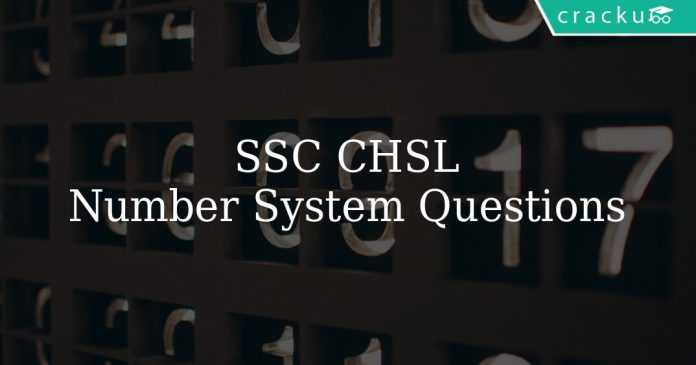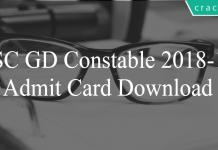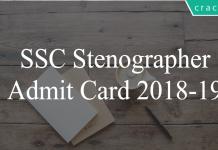SSC CHSL Number System Questions
Download the most important number system questions with solutions for SSC CHSL exam 2020. Most important number system questions based on asked questions in previous exam papers for SSC CHSL. These questions on number systems are really helpful to crack the SSC CHSL exam 2020.
Download SSC CHSL Number System Questions
Get 25 SSC CHSL Mocks – Just Rs. 149
Take a free SSC CHSL Tier-1 mock test
Download SSC CHSL Previous Papers PDF
Question 1: A 4-digit number is formed by repeating a 2-digit number such as 1515, 3737, etc. Any number of this form is exactly divisible by
a) 7
b) 11
c) 13
d) 101
Question 2: If p and q represent digits, what is the possible maximum value of q in the statement 5p9 + 327 + 2q8= 1114?
a) 9
b) 8
c) 7
d) 6
Question 3: Out of six consecutive natural numbers, if the sum of first three is 27, what is the sum of the other three ?
a) 36
b) 35
c) 25
d) 24
Question 4: If’n’ be any natural number. then by which largest number $(n^3 – n)$ is always divisible ?
a) 3
b) 6
c) 12
d) 18
Question 5: I multiplied a natural number by 18 and another by 21 and added the products. Which one of the following could be the sum?
a) 2007
b) 2008
c) 2006
d) 2002
Question 6: The unit digit in the product $122^{173}$ is
a) 2
b) 4
c) 6
d) 8
Question 7: Which one of the following will completely divide 571 + 572 + 573 ?
a) 150
b) 160
c) 155
d) 30
Question 8: When ‘n’ is divided by 5 the remainder is 2. What is the remainder when n2 is divided by 5?
a) 2
b) 3
c) 1
d) 4
Question 9: A student was asked to divide a number by 6 and add 12 to the quotient. He, however, first added 12 to the number and then divided it by 6, getting 112 as the answer. The correct answer should have been
a) 124
b) 122
c) 118
d) 114
Question 10: If $17^{200}$ is divided by 18, the remainder is
a) 1
b) 2
c) 16
d) 17
Join Exam Preparation Telegram Group
Question 11: The unit digit in the sum of (124)372 + (124)373 is
a) 5
b) 4
c) 20
d) 0
Question 12: The next term of the series 1, 5, 12, 24, 43 is
a) 51
b) 62
c) 71
d) 78
Question 13: The least multiple of 13 which when divided by 4, 5, 6, 7 leaves remainder 3 in each case is
a) 3780
b) 3783
c) 2520
d) 2522
Question 14: If 21 is added to a number, it becomes 7 less than thrice of the number. Then the number is
a) 14
b) 16
c) 18
d) 19
Question 15: A number x when divided by 289 leaves 18 as the remainder. The same number when divided by 17 leaves y as a remainder. The value of y is
a) 2
b) 3
c) 1
d) 5
Get 25 SSC CHSL Mocks – Just Rs. 149
Question 16: The value of $\frac{1}{1+\sqrt{2}}+\frac{1}{\sqrt{2}+\sqrt{3}}+\frac{1}{\sqrt{3}+\sqrt{4}}+……+\frac{1}{\sqrt{8}+\sqrt{9}}$ is
a) 1
b) 0
c) 2
d) √2
Question 17: The digit in the unit place in the square root of 66049 is
a) 3
b) 7
c) 8
d) 2
Question 18: The least number that should be added to 2055, so that the sum is exactly divisible by 27 is
a) 28
b) 24
c) 27
d) 31
Question 19: $\frac{1}{\sqrt{7}-\sqrt{6}}-\frac{1}{\sqrt{6}-\sqrt{5}}+\frac{1}{\sqrt{5}-2}-\frac{1}{\sqrt{8}-\sqrt{7}}+\frac{1}{3-\sqrt{8}}$ is
a) 7
b) 0
c) 1
d) 5
Question 20: If $2+x\sqrt{3}$=$\frac{1}{2+\sqrt{3}}$ then the simplest value of x is
a) – 1
b) 1
c) – 2
d) 2
18000+ Questions – Free SSC Study Material
Answers & Solutions:
1) Answer (D)
let’s say digit is pqpq
or pq00 + pq
or pq*100 + pq
or pq (100 + 1)
or pq (101)
hence digit will always be divisible by 101
2) Answer (C)
We can break the sum according to 500 + 10p +9 + 327 + 200 + 10q + 8 = 1114
or 1027 + 17 + 10(p+q) = 1114
or (p+q) = 7
so for q to be maximum p will be zero then q = 7
3) Answer (A)
let’s say 6 consecutive numbers are (a-d), a, (a+d), (a+2d), (a+3d), (a+4d)
where d is the common difference i.e. 1 (given) and a is second term
summation of first three terms will be 3a = 27
hence second term a = 9
now sequence is 8,9,10,11,12,13,
so sum of last three terms 36
4) Answer (B)
$(n^{3} – n) $ can be written as n(n-1)(n+1)
for n to be any natural number, $n^{3} – n$ is a product 3 consecutive numbers starting from 1.
hence for any value of a min. product of 6 will be there hence it is always be divisible by 6.
5) Answer (A)
let’s say one number is n and another number is p
so acc. to question sum will be 18n+21p
and this number will be divisible by 3 so answer will be (A)
6) Answer (A)
As we know a number with unit digit 2 have repeating cycle of 2,4,8,6 after every fourth power
as power is 173 or (172+1) where till 172 , 43rd cycle will get complete and next unit digit will be 2.
7) Answer (C)
Among all options only option C has unit digit 5, and in given equation unit digit will also be 5.
So only 155 can divide the given equation completely.
8) Answer (D)
n = 5k+2 (where k is quotient )
so $n^2 = 25k^2 + 4 + 20k$
Now when $n^2$ will divided by 5 , remainder will be 4.
9) Answer (B)
Let’s say number is N
So according to student result is $112= \frac{N+12}{6} $
or N = 660
Correct answer will be = $\frac{660}{6} +12 = 110+12 = 122$
10) Answer (A)
$17^{200}=(18-1)^{200}$
Hence, when it is divided by 18, the reminder equals $(-1)^{200}=1$
11) Answer (D)
Both of numbers have unit digit as 4 and it has a repeating cycle of 2 with unit digits as 4 and 6
so in first number power is 372 which is exactly divisible by 2 hence unit digit of first number will be 6.
and in second number power is 373 which exceeds one with the reapeating cycle of 2 hence its unit digit will be 4.
now unit digit of the sum will be 6+4 = 10
12) Answer (C)
1+4=5
5+(4+3)=12
12+(4+3+5)=24
24+(4+3+5+7)=43
43+(4+3+5+7+9)=71
13) Answer (B)
Number will be equal to 420t +3 = 13M
put values of M and t accordingly and find least value of it.
14) Answer (A)
21+x=3x-7
or 2x=28
x = 14
15) Answer (C)
The number is of the form 289n+18.
Which is equal to 17*(17n+1) +1
So, when the number is divided by 17, the reminder is 1
Get 25 SSC CHSL Mocks – Just Rs. 149
16) Answer (C)
Expression : $\frac{1}{1+\sqrt{2}}+\frac{1}{\sqrt{2}+\sqrt{3}}+\frac{1}{\sqrt{3}+\sqrt{4}}+……+\frac{1}{\sqrt{8}+\sqrt{9}}$
After rationalizing, the denominator of each term will be 1, the numerator will be
= $\sqrt{2}$ – 1 + $\sqrt{3}$ – $\sqrt{2}$ + $\sqrt{4}$ – $\sqrt{3}$ +…….+ $\sqrt{8}$ – $\sqrt{7}$ + $\sqrt{9}$ – $\sqrt{8}$
Now, all the terms will cancel out except
= $\sqrt{9}$ – 1 = 3-1
= 2
17) Answer (B)
Square root of 66049 = 257
Thus, unit’s digit = 7
18) Answer (B)
The remainder obtained by dividing 2055 by 27 = 3
So, the least number that should be ‘subtracted’ from 2055 to make it perfectly divisible by 27 = 3
and the least number that should be added = 27-3 = 24
19) Answer (D)
$\frac{1}{\sqrt{7}-\sqrt{6}}-\frac{1}{\sqrt{6}-\sqrt{5}}+\frac{1}{\sqrt{5}-2}-\frac{1}{\sqrt{8}-\sqrt{7}}+\frac{1}{3-\sqrt{8}}$
Rationalizing each term, we get, the denominator of each term will be 1, we get :
= $\sqrt{7}$ + $\sqrt{6}$ – ($\sqrt{6}$ + $\sqrt{5}$) + $\sqrt{5}$ + 2 – ($\sqrt{8}$ + $\sqrt{7}$) + 3 + $\sqrt{8}$
= 2+3 = 5
20) Answer (A)
$2+x\sqrt{3}$ = $\frac{1}{2+\sqrt{3}}$
Rationalizing the R.H.S.
=> $2+x\sqrt{3}$ = $\frac{1}{2+\sqrt{3}}$ * $\frac{2-\sqrt{3}}{2-\sqrt{3}}$
=> $2+x\sqrt{3}$ = $\frac{2-\sqrt{3}}{4-3}$
=> $2+x\sqrt{3}$ = $2-\sqrt{3}$
Comparing both sides, we get $x$ = -1





